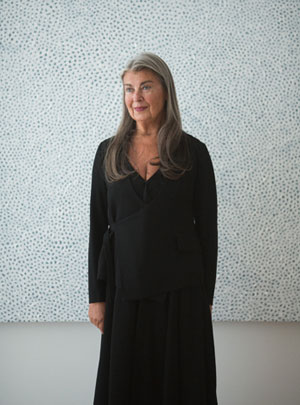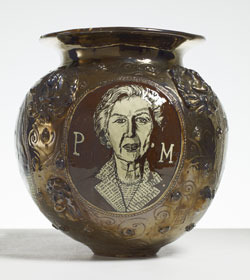Gallerist Victoria Miro on the changing art market scene

Simply sign up to the Life & Arts myFT Digest -- delivered directly to your inbox.
“I’m not very good at interviews,” whispers Victoria Miro as she ushers me into her Islington gallery. Dressed in a black shirt with bold white collar and black jeans, she has, at nearly 70, a commanding presence: long flowing grey hair, strong features – the more theatrical for being offset by a soft, low voice and a light, graceful manner.
Miro rarely speaks about herself and appears not to understand self-promotion. We meet to discuss the opening next week of her second gallery, in Mayfair, but the venue she chooses is her old, familiar space off City Road.
“When I’m in town, I feel strange: it’s a different world. I feel not quite comfortable there,” she admits. “I have to face the reality that not everyone gets out here, there’s so much in central London.” Then she undersells the new gallery, a converted bank office in George Street, a bit more: “It’s not grandiose, it doesn’t have these proportions. But it’s elegant. And artists don’t always want to make big shows. It’s a very pure space, we’re opening with very pure work.”
Yayoi Kusama’s White Infinity Nets, inaugurating Victoria Miro Mayfair, may be pure paintings but are also very marketable. The new works belong to a series of intricate gestural paintings of scalloped white forms begun in the 1950s; they are Kusama’s most recognisable pieces, and in 2008 one formerly owned by Donald Judd fetched $5.1m – then a record for a living woman artist.
Kusama, whom Miro has represented since 1998, was obscure for decades; today she is world famous. Time after time, Miro’s artists have gone from being unknowns to celebrities: Chris Ofili, Grayson Perry, Peter Doig, Conrad Shawcross, Elmgreen & Dragset. Most beguiling is the fact that Miro has established this global reach with only a single London space – until now – in contrast to the loud empire-building of other top 21st-century dealers: Gagosian, David Zwirner, Hauser and Wirth, Jay Jopling’s White Cube all boast several galleries spanning at least two continents.
“The expansion of the art market is a little bit frightening,” Miro says. “It affects production: it doesn’t suit all artists. Work is probably not as precious as it was. We are in a quick world. The collector base is moving. There’s a time element – you can go to an art fair and see so much in a few hours. I really regret that people don’t spend the time to look at things.”
The daughter of a Jewish stallholder in Covent Garden’s fruit and vegetable market – “I would define myself as a Jewish dealer” – Miro grew up “in a very working-class family but they were interested in culture; my father loved music. When I started to become interested in art, he took me every year on my birthday to [Charing Cross Road art bookshop] Zwemmer and I was allowed to choose any art book for £5 – an enormous amount in those days.”

She studied painting at London’s Slade School of Fine Art – “a huge help, I know what it means to face an empty canvas, I appreciate when you find that something that you struggle to achieve.” Then she married a lawyer, “and when I had children, something changed.” No longer wanting to make work, she became “an old-fashioned, stay-at-home mum”.
Once her children started school, Miro launched her first gallery. With a young Jake Chapman as gallery technician and occasional babysitter – “he was always talking about this brother of his who was a painter” – she took over a tiny space in Cork Street in 1985 from Robert Fraser, who was dying of Aids. “You’ll never make a contemporary gallery work in this country,” Fraser warned; her opening show, of conceptual maverick Ian Hamilton Finlay, sold nothing.
Being a dealer, she says, “is very much getting people to kind of fall in with what you are proposing. What you are trying to do is present the artist in the very best way possible so that other people see in that artist what you see.”
The best part is “the work, being close to the work, studio visits – you see the work appear, radically change, progress, you know why you’re interested in it, you see the daring.”
The worst is “art fairs. They’re tough, it’s very much about commerce – how much, what discount can I get – it’s very blunt, there’s no time for interesting conversations. There’s too much emphasis on investment. There’s always an element of speculation in a collector but now too many collectors buy with investment in mind. The sad thing is that everyone is chasing the same artists and fewer risks are taken. I can even tell from my own stable – some are so sought-after, others as good are finding it more difficult – it’s such a shame.”
Her response is “to keep showing those whom you really believe in who are not at the top, keep promoting them, make sure they are seen. If you just saw it from a financial angle, you would drop them – it would be awful. You can’t predict [an artist’s career]; you have the right feeling, intuition, but you don’t know.
“Older artists are less of a risk, you know they’re going to endure. When you take on a young artist, you see something there that is interesting, but you can’t know how they will develop. Sometimes they blossom, sometimes they don’t develop. You meet young artists and they have so many gifts – colour, line, everything is brilliant – like Chris [Ofili]. He could have become stuck but he didn’t; he’s grown, pushed, changed. Working with him is one of the highlights – it’s so exciting, dynamic, you never know what’s coming next.”
Miro’s range of artists is “eclectic, there’s no line, it’s a personal selection. But I do love painting. It’s not that I don’t have a great respect for other media but painting is my real love.” Her championship of gifted mid-career painters – Jules de Balincourt, Hernan Bas, Varda Caivano, John Korner – as well as the estate of Alice Neel (“I live with a beautiful Alice Neel nude, it so obviously references Goya’s ‘Naked Maja’”) is distinctive at a time when galleries are growing ever larger, and their identities increasingly homogenised.
Miro’s stable by contrast remains small; she does not take on even a commercially successful artist “if I don’t feel enough emotion for the work. I want to get people’s emotional reaction, I want them to look.”
She suddenly waves an arm as if to encircle the big, glassy gallery. “These spaces, it’s like a little castle for me, it’s very magical for me. I don’t want to blow my own trumpet but that’s how I feel when I come here. I don’t know if I’ll achieve that in Mayfair, but who knows?”
‘Yayoi Kusama, White Infinity Nets’, Victoria Miro Mayfair, October 1-November 9. www.victoria-miro.com
Comments